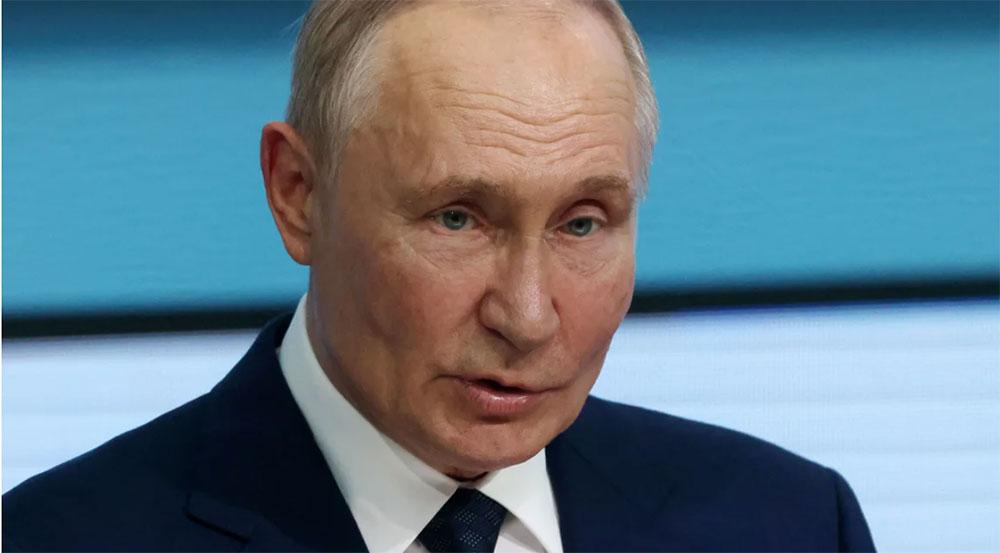13 Sep 2024 - {{hitsCtrl.values.hits}}
 CNN - Russian President Vladimir Putin has warned that NATO allowing Ukraine to use longer-range missiles to strike inside his country would be seen by Moscow as the bloc’s direct entry into the war.
CNN - Russian President Vladimir Putin has warned that NATO allowing Ukraine to use longer-range missiles to strike inside his country would be seen by Moscow as the bloc’s direct entry into the war.
Putin’s comments come as US and Western diplomats appear increasingly open to the possibility of lifting restrictions on Ukraine’s use of US-provided long-range weapons systems, which Kyiv has openly pressed for, more than two years into Russia’s invasion.
“This will mean that NATO countries – the United States and European countries – are at war with Russia,” Putin told reporters on Thursday.
“And if this is the case, then, bearing in mind the change in the essence of the conflict, we will make appropriate decisions in response to the threats that will be posed to us,” Putin added.
Although the US has shifted its policy to allow limited cross-border strikes into Russia using US-provided weapons, President Joe Biden’s administration has yet to allow longer-range strikes.
US officials have expressed concerns that allowing Ukraine to strike deep inside Russia could escalate the conflict and cause Russia to further accuse the US of being part of the war. A US official told CNN Tuesday that US intelligence shows Russia has moved a number of assets outside of the reach of long-range strikes.
During a recent visit to Kyiv, US Secretary of State Antony Blinken offered the strongest suggestion yet the White House could yet lift restrictions in line with a strategic shift.
“From day one, as you heard me say, we have adjusted and adapted as needs have changed, as the battlefield has changed, and I have no doubt that we’ll continue to do that as this evolves,” Blinken said, alongside Ukrainian Foreign Minister Andrii Sybiha and Britain’s Foreign Secretary David Lammy.
Blinken said he discussed the restrictions with Ukrainian President Volodymyr Zelensky and would report back to President Biden.
Biden is facing pressure at home from lawmakers on both sides of the aisle to ease the restrictions as Ukraine struggles to consolidate its advances.
On Tuesday, the bipartisan congressional Ukraine caucus called on Biden to allow Ukraine to strike targets inside Russia with the long-range weapons.
A group of key House Republicans also wrote to the president this week ahead of Blinken’s Ukraine trip, echoing appeals from Zelensky to lift the restrictions.
Putin on Thursday also raised doubts about whether Kyiv could carry out long-range strikes alone, saying “the Ukrainian army is not capable of using cutting-edge high-precision long-range systems supplied by the West” without NATO assistance in targeting.
The United States already does provide intelligence to Ukraine, and has previously assisted in the targeting, although not with the long-range systems currently being considered.
According to Center for a New American Security Senior Fellow Dr. Stacie Pettyjohn, there may also be other intelligence resources available to Ukrainian forces, including commercial satellite imagery, depending on the target.
In a press conference on Thursday Blinken reiterated that, as part of continuing military assistance to Ukraine, the US provides intelligence to Ukrainian forces, but declined to answer whether the US would increase its intelligence sharing.
The United States first provided Ukraine with long-range Army Tactical Missile System (ATACMS) missiles, which have a maximum range of about 180 miles (290 kilometers), in October of 2023. Kyiv has long called on its Western backers to allow the use of weapons systems that would provide a longer reach inside Russian territory.
In an interview with CNN’s Alex Marquardt, Ukrainian Defense Minister Rustem Umerov said that “the airfields [Russia is] using to hit our cities are within the range of deep strikes.” To date, Ukraine has used its existing supply of long-range ATACMS to target high-value Russian assets in occupied Crimea, including air defenses, ammo depots and airfields.
If NATO countries move forward with authorizing the use of Western weapons for long-range strikes inside Russian territory, this technology could be used to target close-range ballistic missile (CRBM) systems that arrived in-country from Iran in recent weeks, former US ambassador William Courtney, now an adjunct senior fellow at the RAND Corporation, told CNN. With a range of just 75 miles, a US-made system like ATACMS “could hit anything at that distance and well beyond,” he told CNN.
29 Nov 2024 4 hours ago
29 Nov 2024 5 hours ago
29 Nov 2024 6 hours ago
29 Nov 2024 6 hours ago
29 Nov 2024 7 hours ago